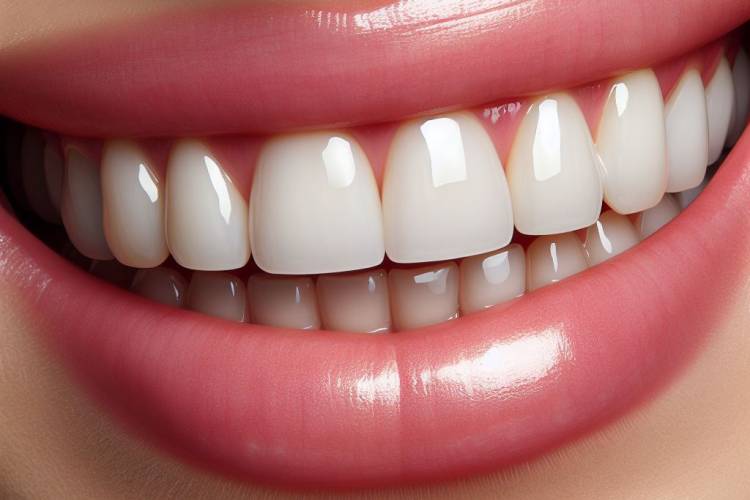Are you dreaming of a brighter, more confident smile? Look no further than veneers in Mumbai, specifically at Pristine Juhu. Veneers are like magic shells that cover your teeth, giving them a brand-new look.
What Are Veneers?
Veneers are thin, custom-made shells that are placed over the front surface of your teeth. They’re like little covers that hide imperfections and give you a dazzling smile.
Whether you have stains, chips, gaps, or uneven teeth, veneers can make it all disappear, leaving you with a flawless grin.

Why Choose Veneers?
Veneers are a popular choice for smile makeovers because they offer many benefits:
- Instant transformation: With veneers, you can get a beautiful smile in just a few visits to the dentist.
- Natural appearance: Veneers are designed to look like real teeth, so nobody will know you’ve had work done.
- Durable and long-lasting: With proper care, veneers can last for many years, keeping your smile looking great for a long time.
- Stain-resistant: Veneers are resistant to stains from coffee, tea, and other common culprits, so you can enjoy your favourite drinks without worrying about discoloration.
Understanding the Evolution and Science Behind Dental Veneers
Since the 1930s, dental veneers have been pivotal in improving both the aesthetics and protection of teeth (Calamia, 1988).
These thin shells have a myriad of applications, ranging from addressing discoloration due to various factors like tetracycline staining or fluorosis to restoring fractured or worn teeth, correcting abnormal tooth morphology, and even intra-oral repair of fractured crown and bridge facings.
However, while veneers offer a transformative solution for many, certain conditions like parafunctional habits (e.g., bruxism), poor oral hygiene, or insufficient enamel pose challenges.
Materials Evolution in Dental Veneers
Over the years, the materials used for dental veneers have undergone significant advancements. Early materials had drawbacks such as thickness requirements to cover discoloration, difficulty in polishing leading to abrasion, and susceptibility to staining.
However, in the 1970s, laminate veneers emerged as a promising alternative, offering better aesthetics and efficiency. The 1980s saw a leap with the introduction of porcelain veneers, revolutionizing aesthetics as enamel etching and surface treatment enhanced bonding.
Innovations in Preparation Designs
In parallel with material advancements, new preparation designs emerged, aiming for more durable and aesthetic outcomes. These designs include window, feather, bevel, and incisal overlap preparations, each tailored to specific clinical scenarios. However, opinions vary regarding the superior design, highlighting the need for evidence-based approaches.
Preparation Designs on Veneer Survival
Understanding how different preparation designs impact the longevity of veneers is crucial for achieving successful outcomes. While clinical trials in this area are limited, researchers have turned to in vitro studies to gain valuable insights into the effects of various preparation techniques.
Incisal Overlap Preparations
One commonly studied preparation design is the incisal overlap technique. This approach involves slightly reducing the length of the incisal edge of the tooth and extending the veneer slightly onto the palatal aspect.
Research suggests that incisal overlap preparations tend to provide better support for the veneer and distribute occlusal forces more evenly. This means that the veneer is less likely to experience excessive stress, reducing the risk of fractures or failures.
Window Preparations
In contrast, window preparations involve minimal reduction of the tooth structure, particularly at the incisal edge. While this technique may preserve more of the natural tooth, studies indicate that it can concentrate stress on the veneer, especially in the incisal third.
This concentration of stress increases the likelihood of fractures or failures, compromising the longevity of the veneer.
Considerations for Clinical Practice
When choosing a preparation design for veneers, clinicians must consider individual patient factors and preferences. While incisal overlap preparations may offer better support and durability, window preparations may be preferred in certain cases to preserve more natural tooth structure.
Ultimately, the choice of preparation design should be guided by a thorough assessment of the patient’s oral health, aesthetic goals, and risk factors for veneer failure.
By selecting the most appropriate preparation technique, clinicians can optimise the longevity and success of veneer restorations for their patients.
Understanding Material Selection of Veneer
Choosing the right material for dental veneers is a critical decision that impacts their longevity and performance. Two common materials used for veneers are porcelain and resin composites, each offering unique advantages and considerations.
Porcelain Veneers
Porcelain veneers, especially those crafted from feldspathic porcelain, have garnered recognition for their reliability and effectiveness in restoring front teeth.
These veneers possess exceptional durability and natural aesthetics, making them a popular choice among patients seeking long-lasting smile enhancements.
However, it’s important to note that porcelain veneers may present challenges such as fabrication sensitivity and susceptibility to fracture, requiring careful handling and maintenance.
Resin Composite Veneers
Resin composite veneers provide a versatile alternative to porcelain, offering the convenience of direct application and reduced chair time during procedures.
While resin composites offer excellent aesthetic results initially, they are more prone to wear and discoloration over time compared to porcelain veneers.
Despite these drawbacks, resin composites remain a preferred choice for certain patients due to their affordability and ease of application.
Considerations for Optimal Outcomes
When selecting veneer materials, clinicians must carefully evaluate the patient’s individual needs and preferences. Factors such as the desired longevity of the veneers, budget considerations, and aesthetic goals should all be taken into account.
By weighing the advantages and limitations of porcelain and resin composite veneers, clinicians can tailor their treatment approach to achieve the best possible outcomes for their patients’ smiles.
Challenges in Veneer Placement
While dental veneers offer transformative benefits for enhancing smiles, clinicians often encounter various challenges during the placement process. Understanding and effectively addressing these challenges are crucial for achieving successful outcomes and patient satisfaction.
1. Structural Integrity:
One of the primary challenges in veneer placement is ensuring the structural integrity of the tooth substrate. Insufficient enamel or compromised tooth structure can compromise the bonding strength of the veneer and increase the risk of failure over time. Clinicians must carefully assess the structural integrity of the tooth and may need to explore alternative treatment options, such as dental crowns, for teeth with extensive damage.
2. Occlusal Forces:
Occlusal forces exerted during chewing and biting can pose challenges for veneer longevity. Excessive or uneven forces on the veneered teeth can lead to premature wear, chipping, or even fracture of the veneer. Clinicians must carefully evaluate the patient’s occlusal function and may recommend occlusal adjustments or the use of occlusal guards to alleviate excessive forces and protect the veneers.
3. Parafunctional Habits:
Patients with parafunctional habits, such as bruxism (teeth grinding) or clenching, present unique challenges for veneer placement. These habits can exert excessive forces on the veneered teeth, leading to accelerated wear and potential veneer failure. Clinicians must assess and address parafunctional habits before proceeding with veneer placement, which may involve the use of protective appliances or behavioral modification techniques.
4. Aesthetic Expectations:
Meeting patient expectations for aesthetic outcomes can be challenging, especially when addressing complex dental issues such as tooth discoloration, misalignment, or irregularities. Clinicians must effectively communicate with patients to manage their expectations and ensure realistic treatment goals. Additionally, achieving optimal aesthetics may require meticulous planning, shade matching, and artistic skill during veneer placement.
5. Long-Term Maintenance:
Maintaining the long-term stability and aesthetics of veneers requires ongoing care and maintenance. Patients must adhere to proper oral hygiene practices, including regular brushing, flossing, and professional dental cleanings, to prevent plaque accumulation and minimize the risk of complications such as decay or gum disease around the veneers. Additionally, clinicians may recommend periodic evaluations and maintenance procedures, such as veneer polishing or replacement, to ensure the continued success of the veneer restoration.

Why Pristine Smiles, Juhu?
Now that you know how awesome veneers are, let’s talk about why Pristine Juhu is the best place to get them in Mumbai:
Expert care: The team at Pristine Juhu consists of experienced and skilled dentists who specialize in cosmetic procedures like veneers.
Personalized treatment: Your smile is unique, and the experts at Pristine Juhu will tailor your veneers to suit your individual needs and preferences.
State-of-the-art facilities: Pristine Juhu is equipped with the latest technology and amenities to ensure your comfort and satisfaction throughout the treatment process.
Convenient location: Located in the vibrant neighborhood of Juhu, Pristine Juhu is easily accessible and surrounded by shops, restaurants, and other attractions.
Ready to Transform Your Smile?
If you’re ready to say goodbye to imperfections and hello to a stunning smile, veneers at Pristine Juhu are the way to go. Schedule a consultation today and take the first step towards achieving the smile of your dreams. With veneers in Mumbai, your journey to a brighter, more confident smile starts here!
FAQs
What are veneers?
Veneers are thin shells made of porcelain or composite resin that are custom-designed to cover the front surface of teeth. They are used to improve the appearance of teeth by masking stains, chips, or gaps and creating a more uniform smile.
How are veneers applied?
The process begins with a consultation where the dentist assesses your smile and discusses your goals. During the application, a small amount of enamel is removed from the teeth to make room for the veneers. Then, the veneers are bonded to the teeth using a special adhesive.
Are veneers permanent?
Veneers are considered a permanent cosmetic solution, as they typically last for many years with proper care. However, they may need to be replaced eventually due to wear and tear.
Do veneers look natural?
Yes, veneers are designed to mimic the natural appearance of teeth, including their color, shape, and texture. With proper customization and placement, veneers blend seamlessly with your smile for a natural-looking result.
Are veneers stain-resistant?
Porcelain veneers are highly resistant to stains from food, beverages, and tobacco. However, it’s still important to maintain good oral hygiene to prevent any discoloration over time.
How do I care for veneers?
Veneers can be cared for just like natural teeth, with regular brushing, flossing, and dental check-ups. Avoid biting hard objects and using your teeth as tools to prevent damage to the veneers.
Can veneers fix crooked teeth?
While veneers can improve the appearance of mildly crooked teeth, they are not a substitute for orthodontic treatment. Severe misalignment may require braces or other orthodontic solutions.
Are veneers suitable for everyone?
Veneers are a versatile option for many people seeking cosmetic improvements to their smile. However, they may not be suitable for individuals with severe dental issues or inadequate tooth structure.
How long does the veneer process take?
The entire veneer process typically requires two to three appointments. This includes the initial consultation, tooth preparation, and placement of the veneers. The exact timeline may vary depending on individual needs.
Is the veneer procedure painful?
Most patients report minimal discomfort during the veneer procedure. Local anesthesia is often used to numb the area, ensuring a comfortable experience. After the procedure, some sensitivity may occur, but it usually subsides quickly.
Pristine Smiles Dental Care Juhu
1, Jayanti Niwas, opp. Vaishali Hotel, Near Iskcon Temple, Jukarwadi, Juhu, Mumbai, Maharashtra 400049
